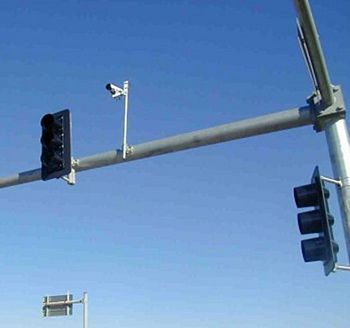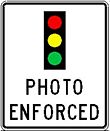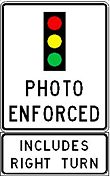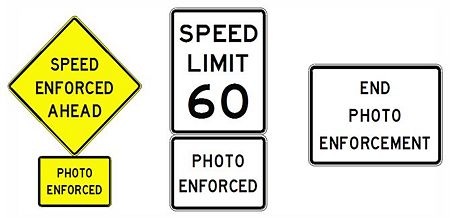Category:950 Automated Traffic Enforcement

Request for the use of automated traffic enforcement systems will be made by the city and/or county desiring to use them, with the exception of work zones. This includes permission to conduct violation studies.
950.1 Automated Traffic Enforcement at Signalized Intersections
950.1.1 Automated Enforcement of Red-Light Violations
Severe crashes at signalized intersections are usually a result of non-compliance with a traffic signal. Automated enforcement, when used correctly, is an effective tool for reducing crashes at signalized intersections. The objective of using the cameras is to improve intersection safety. However, not all intersections are candidates for automated enforcement.
To ensure red-light violations are mitigated as completely and as feasibly possible, state highway intersections selected for installation of automated red-light violation enforcement equipment will undergo an engineering review and, if needed, a violation study prior to the installation of automated red-light violation enforcement equipment. MoDOT will conduct the engineering study to ensure the cameras will not impact the existing signal operation and meet a need for their installation. The city and/or county will provide the information from the violation study.
950.1.2 Engineering Study
Crash data will be used to determine the contributing causes and collision types for crashes at each approach of the intersection. Contributing causes (failure to yield, inattention, violation of the signal, etc.) and collision types (right angle, left-turn right angle, right-turn right angle) that are expected to be improved by the installation of automated enforcement should be investigated further.
Site evaluation information includes a review of the intersection to ensure components of the signal are visible and conspicuous (signal heads, signs, the intersection itself) and the timing is appropriate for the conditions (change interval, green interval, dilemma zone).
After reviewing the crash data and site evaluation information, engineers should identify and select the appropriate countermeasures, if any, that could reduce the violations. Countermeasures are applicable to several parts of the intersection such as visibility of the traffic signal, visibility and conspicuity of the signal indications and signs, and timing of the signal phases and signal system. If major modifications are identified for implementation, negotiate with the city the cost of the improvements.
Crash Warrant for Installation
Cameras may be installed if an intersection (all approaches included) has at least one severe crash (fatal or disabling injury) related to red-light running in the previous 10 years AND has more than 10 red-light running crashes in the previous 5 years. Red-light running crash types are right angle, left-turn right angle, right-turn right angle, and crashes involving pedestrians.
Automated enforcement is not recommended for other crash types. If the crash warrant is met, the crashes should be reviewed in order to determine which approaches are most likely to experience a safety benefit with the addition of cameras. If a determination cannot be made or if a request is made for cameras on an approach not deemed a good candidate based on the crash data, a violation study should be conducted to help identify the approaches on which cameras should be installed. If the crash warrant is not met and the city and/or county still wants to proceed with the installation, a violation study must be conducted and the request will be sent to the State Traffic Engineer for further review.
950.1.3 Violation Study
When conducting a violation study, all approaches will be evaluated to determine if one approach or all approaches are experiencing the same number of red-light violations. A violation study will be completed for each approach of the intersection and will be conducted for a duration of at least 12 consecutive hours between the hours of 6:00 am and 6:30 pm or as directed by the engineer. The start time of the violation study may vary between 6:00 am or 6:30 am depending on traffic conditions of the area and should be a representative sample of traffic volume for that specific location. Violation information will be provided by the city and/or county.
950.1.4 Approach Selection
If by reviewing the crash reports it can be determined which approaches are violating the red signal indication, cameras may be installed on those approaches. If any other approach is chosen for the installation of cameras and/or the crashes do not indicate which approach is violating the red signal indication, then a violation study is to be conducted in accordance with the EPG 950.1.3 Violation Study requirements.
950.1.5 Conditions for Installation for Intersections with Automated Red-Light Violation Enforcement Equipment Installed After January 2011
If automated red-light violation enforcement equipment is approved for installation, the following conditions must be met:
- 1. If any one approach is selected to be monitored, then any other approach with a similar or higher crash or violation experience should also be enforced.
- 2. A duly sworn, Peace Officer Standards and Training (POST) certified law enforcement officer shall review and make the determination of any violation.
- 3. Advance signing will be required on each intersection approach with automated enforcement as shown below. MoDOT will install the signs on state right of way and provide the signs to the city and/or county for installations on city and/or county right of way.
 |

|
- The PHOTO ENFORCED sign will be used for approaches where a YIELD sign is used for the right turns. The PHOTO ENFORCED INCLUDES RIGHT TURN sign will be used for approaches where no YEILD sign is present for the right turns.
- 4. The city and/or county shall conduct a public awareness campaign at least 30 days prior to issuing citations.
- 5. The city and/or county will be required to submit an annual report to MoDOT for each state highway intersection in such city and/or county which has automated red-light enforcement equipment. The report will be due January 31 and include the following information from the previous year:
- a. Safety performance
- i. Number of crashes
- ii. Severity of crashes; number of fatal, disabling injury, minor injury, and property damage only, if able.
- a. Safety performance
- b. Number of citations
- i. Total number and
- ii. Citations by maneuver (i.e. left turn, thru or right turn), if able
- b. Number of citations
- 6. The city and/or county must enter into a contract (TR43) with the Missouri Highways and Transportation Commission (MHTC) for the use of an automated red-light violation enforcement equipment system on state-maintained highways. Part of the contract will require an ordinance allowing the use and issuance of citations using automated red-light violation enforcement equipment. Once a contract is executed and a Permit to Work on Right of Way is issued, the city and/or county may proceed with the installation of the equipment.
950.1.6 Conditions for Installation for Intersections with Automated Red-Light Violation Enforcement Equipment Installed Prior to January 2011
The conditions for installation for locations installed prior to January 2011 will be as follows:
- 1. Engineering or violation studies are not required.
- 2. A duly sworn, Peace Officer Standards and Training (POST) certified law enforcement officer shall review and make the determination of any violation.
- 3. Advance signing will be required on each approach with automated enforcement as shown below. MoDOT will install the signs on state right of way and provide the signs to the city and/or county for installations on city and/or county right of way.
 |

|
- The PHOTO ENFORCED sign will be used for approaches where a YIELD sign is used for the right turns. The PHOTO ENFORCED INCLUDES RIGHT TURN sign will be used for approaches where no YEILD sign is present for the right turns.
- 4. The city and/or county will be required to submit an annual report to MoDOT for each state highway intersection in such city and/or county which has automated red-light enforcement equipment. The report will be due January 31 and include the following information from the previous year:
- a. Safety performance
- i. Number of crashes
- ii. Severity of crashes; number of fatal, disabling injury and property damage only, if able.
- a. Safety performance
- b. Number of citations
- i. Total number and
- ii. Citations by maneuver (i.e. left turn, thru or right turn), if able.
- b. Number of citations
- 5. Execute a new agreement (TR43) stating the new conditions of the installation.
These conditions are for approaches with automated enforcement equipment present. If there are any additions or changes to which approach is enforced, then the installation is considered a new installation and will follow the guidance in Conditions for Installation for Intersections with Automated Red-Light Violation Enforcement Equipment Installed After January 2011.
Districts should contact any cities or counties with existing installations to identify any gaps with current installations and then work with the city and/or county to develop strategies and a timeline to bring the existing location into compliance. If the city is unwilling to meet the guidance of EPG 950.1.6 Conditions for Installation for Locations Installed Prior to January 2011, the state traffic engineer shall be notified and the automated red-light violation enforcement equipment shall be removed and the permit and agreement cancelled.
950.2 Automated Enforcement of Speed Violations
Cameras may be used to assist with enforcement of state speed limit laws in school zones, work zones and Travel Safe Zones on the state highway system. Use of automated speed enforcement equipment in any other location is not allowed. All requests for the use of automated speed enforcement must be approved by the State Traffic Engineer.
For school zones, the following will apply:
- 1. Engineering study and violation study will be conducted prior to the installation of automated speed enforcement equipment. The city/county will provide the violation study.
- 2. The engineering study will consist of determining the speed limit for the school zone and shall be established based on EPG 903.19.6 Lettering and EPG 949.2.2.
- 3. Where school speed limit signing is installed, flashers shall be installed with the signing. The flashers are only activated at times when the school speed limit applies. The speed limit should only be active during times when children are likely to be present. See EPG 902.12.4 Speed Limit Sign Beacon for additional information.
- 4. Automated speed enforcement equipment will not be allowed in school zones without a reduced speed limit or flashers.
- 5 Installations may be either permanent or mobile equipment. For mobile installations, device must either be placed where it is unreachable by vehicles, NCHRP 350 compliant or protected from vehicular impact. Vendor must supply letter from FHWA of NCHRP compliance.
- 6. For permanent installations, MoDOT will provide and install the signs. For mobile installations, city/county is responsible for providing the signs and having signs present when conducting automated enforcement of speed. Signs must be crashworthy.
- 7. Permit will be required to allow the city to place equipment and signs on right of way.
For work zones, the following will apply:
- 1. Use of automated speed enforcement equipment in work zones will be reserved for those work zones that
- a. Have a duration of at least 4 hours
- b. Reduced speed limits are in effect
- c. Normal posted speed limit is 60 mph of greater
- d. Within a municipal boundary
- 2. MoDOT will initiate the request for the use of automated enforcement of speed.
- 3. Work zones must be marked by a ROAD WORK AHEAD and END ROAD WORK signs.
- 4. The speed limit for the work zone shall be established based on EPG 616.12 Work Zone Speed Limits.
- 5. Automated speed enforcement shall only occur when workers are present and allowed only for the duration of the work zone.
- 6. One automated speed enforcement equipment installation per work zone, even when boundaries of the work zone cross several jurisdictions. Installation is allowed to be moved to different areas within the work zone.
- 7. Installations shall be mobile equipment and city/county is responsible for providing the signs and having signs present when conducting automated speed enforcement.
- 8. For mobile installations, device must either be placed where it is unreachable by vehicles, NCHRP 350 Test Level 3 compliant or protected from vehicular impact. Vendor must supply letter of acceptance from FHWA of NCHRP compliance.
- 9. Permit will be required to allow the city to place equipment and signs on right of way.
For Travel Safe Zones, the following will apply:
- 1. Travel safe zones shall be established in accordance with RsMo 304.590 and the guidance in EPG 907.3 Travel Safe Zones. Automated speed enforcement should be noted as a strategy in the work plan and approved by the State Traffic Engineer.
- 2. Automated speed enforcement can only be used during the duration of the Travel Safe Zone. Once the Travel Safe Zone has expired, so will the use of automated speed enforcement.
- 3. Installations may be either permanent or mobile equipment. For mobile installations, device must either be placed where it is unreachable by vehicles, NCHRP 350 compliant or protected from vehicular impact. Vendor must supply letter from FHWA of NCHRP compliance.
- 4. For permanent installations, MoDOT will provide and install the signs. For mobile installations, city/county is responsible for providing the signs and having signs present when conducting automated enforcement of speed.
- 5. Permit will be required to allow the city to place equipment and signs on right of way.
Conditions for Installation
If automated speed enforcement equipment is approved for installation, the following conditions must be met:
- 1. A duly sworn, Peace Officer Standards and Training (POST) certified law enforcement officer shall review and make the determination of any violation.
- 2. A city/county shall conduct a public awareness campaign at least 30 days prior to issuing citations.
- 3. For any automated speed enforcement location, advanced signing warning of the automated enforcement is required and shall be of the type below.

- For mobile installations, the SPEED ENFORCED AHEAD assembly shall be used and provided by the city/county and present during times of enforcing the speed limit with automated enforcement equipment. These will probably be roll-up or portable type signs. For permanent installations, the SPEED LIMIT XX PHOTO ENFORCED assembly and END PHOTO ENFORCEMENT sign shall be used and installed by MoDOT. The downstream end of a photo enforced speed limit zone shall be identified with an END PHOTO ENFORCEMENT sign.
- 4. The city/county will be required to submit an annual report to MoDOT for each state highway corridor in such city/county which has automated speed enforcement equipment. The report will be due January 31 and include the following information from the previous year:
- a. Safety performance
- i. Number of crashes
- ii. Severity of crashes; number of fatal, disabling injury and property damage only, if able.
- b. Number of citations
- 5. Enter into a contract (TR36) with the Missouri Highways and Transportation Commission (MHTC) for the use of an automated speed enforcement system on state-maintained highways. Part of the contract will require an ordinance allowing the use and issuance of citations using automated speed enforcement equipment. Once a contract is executed and a Permit to Work on Right of Way is issued, the city/county may proceed with the installation of the equipment.